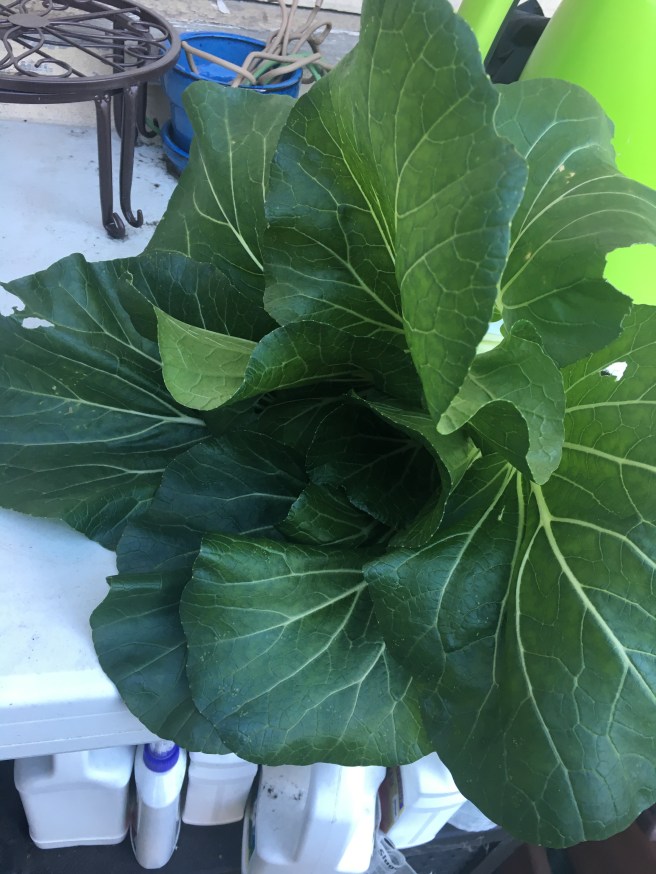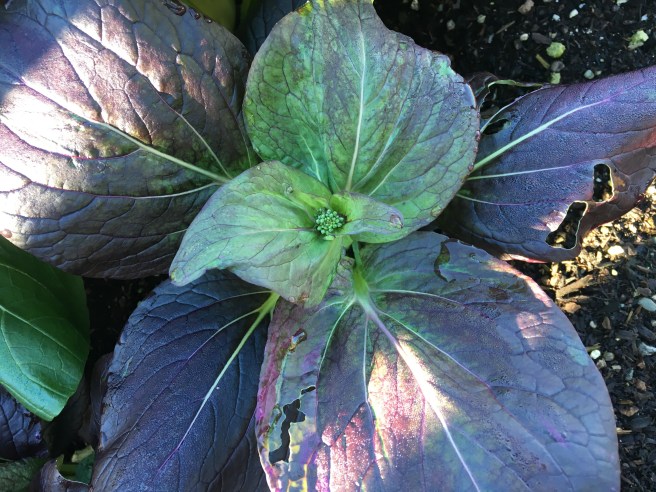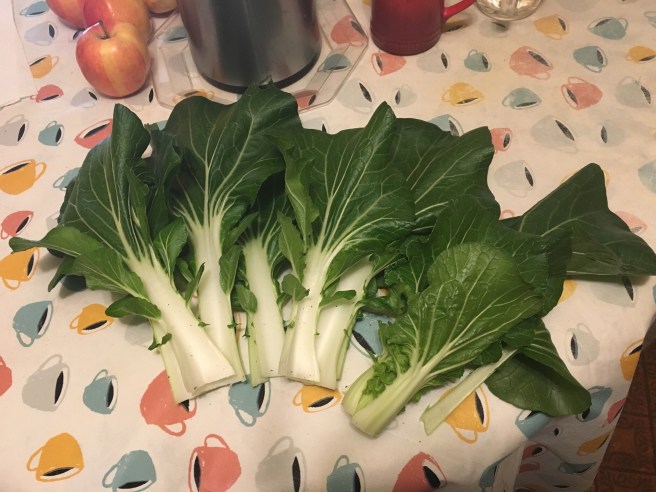Or in the case of the first two names, Cantonese.
It’s my 100th post! So since I harvested my first Bok Choy of the year, I thought I’d do a deep dive into one of my favorite cabbages!

Bok Choy, also know as Pac Choi, which is how my garden center spells it- is a member of the cabbage family of plants. Specifically, Bok Choy is Brassica rapa. Now the really really cool thing about cabbages is that we’ve been breeding them for so long that even members of the same species of cabbage can have wildly different forms based on the specific cultivar or variety.

Bok Choy, is one of two cabbages sometimes referred to as “Chinese Cabbage” the other of course being napa cabbage. Both are members of the same species, but if you’ve ever put a napa cabbage and a bok choy together, you’ve probably noticed they look quite different.
Here’s where it gets crazier. The “rapa” in the scientific name is Latin for turnip.
That’s right! The turnip is also Brassica rapa! in other words, the Bok Choy I’m growing in one part of my garden, and the turnips I’m growing in another, are the same species of plant!
Bok Choy and Pac Choi are just different ways of transliterating the Cantonese word for the plant into English, traditionally the first is American English while the second is British English. Which raises a few questions as to why a plant nursery in California is using the British transliteration? Who knows.

Even varieties within a specific cultivar can look and grow quite different. This is the Rosy cultivar I’ve been growing along with the green and white type, which is called “Joi Choi”. The Joi Choi is growing really well and big, while the purple type is… growing. As you can see in the picture, the interior is flowering, which makes no sense- that’s usually something that gets triggered by heat, and it’s January. Now the flowering part is most likely totally edible, that’s what Cauliflower and Broccoli are after all, a cabbage that was bred for it’s edible flowers. (That however is Brassica oleracea, the species that includes cabbages proper, kale, Brussels sprouts and the aforementioned cauliflower and broccoli). So even if it is growing weirdly- I’ll still eat it.
I’m hoping that as I harvest the Joi Choi, the added space will cause the Rosy cultivar to grow a bit better. Or it might not, and I’ll just harvest all the purple ones all together for baby bok choy. Either way, I win. Such is the way of cabbages.

Bok Choy is like a lot of cabbage species and cultivars in that it needs a good wash. It’s not as bad as something like a leek, or god forbid, artichokes- which will never grace my garden kill them with fire they are bug hotels. But you still need to cut off the root end and give everything a good rinse. Depending on how you’re cooking them (or if you plan to eat them raw) you might not even use a salad spinner or towels to dry them off. I don’t.

General cooking advice is to cook them like chard or kale, separate the leaves from the stems, cut both up, saute the stems first in a little oil and salt, and once those are starting to soften, throw in the leaves and finish it up with a good grind of pepper. Bok Choy are also good in stir fry, just add the stems first and the leaves at the end along side whatever other veggies and proteins are in your fry.
This bad boy was actually destined for some braised steaks, added into the braising liquid along with some carrots and onions, steaks nestled inside, and slow cooked in the oven for two hours. It was delicious.

Now I use starts to save time, but much as growing turnips from seed is super easy peasy, so is growing bok choy. Brassica rapa is just one of the easier vegetables to grow, and I’ve done it year round. They might not love the hottest of summers, but as long as you grow them in the shade they should be fine. Similarly, while there is not a real danger of frost out here, in places where it does snow, you can grow Bok Choy easily in cold frames. Like most cabbages, they’re resilient and easy to grow, a testament to the fact that they are the modern descendants of one of the first vegetable species domesticated by humans.
One caveat. Like all cabbages they will attract some bugs. One of the reasons I prefer raised beds and growing my cabbages in the colder months is because of a nasty but pretty little white moth called a cabbage moth or cabbage butterfly. Two species of this winged foe exist, Pieris brassicae and Pieris rapae. The fact that their species name translates into cabbage and turnip respectively should tell you everything about their preferred food. But they’re not the only ones. The last time I grew turnips in the ground instead of in a raised bed, I lost 90 percent of my crop to an unknown grub, that I only discovered while cutting into my turnips. (EW.) But the various grubs and the cabbage moths are much more active in the summer. What is active this time of year is slugs and snails, especially after all this rain. That’s most likely the culprit behind the few scattered holes on the bok choy. I put down the slug bait, but honestly? A few holes in your cabbages won’t spoil your dinner. (Grubs in your turnips on the other hand…)
So give growing Bok Choy (or Pac Choi) a try! It’s easier than you think, and the rewards are delicious.
I can’t believe I’ve managed to crank out 100 posts in less than a year. I still feel slightly like I’m shouting into the void, but it’s a nice hobby, and I hope I’m brightening someone’s day. Thanks to everyone who reads this- here’s to my garden, and yours!


An echo from the void – please keep going, you have an interesting garden growing there. Brassicas are weird things for sure – my copy of Vegetables by Philips and Rix has such a variety of brassicas it’s not funny.
Thank you for your kind words, I know I have to do work promoting and such, which I’m not really good at, but I’m glad some people seem to be enjoying this blog!
Brassicas are possibly the oldest of the non-cereal grain plants to be domesticated and as such we’ve been tinkering with them for so many thousands of years- it’s no wonder they have so many wild and crazy forms! I think later this year I might try for Brussels sprouts!
I have a book Vegetable by Philips and Rix with so many odd brassicas in it that I’m hoping to have a go at in our new garden when we finally move in later this month.
There’s a cultivar of Brassica Oleracea (the same species as broccoli/cauliflower/B. Sprouts) called Gai Lan (also known as Chinese Broccoli) that living in San Francisco is quite common here- it might grow well in NZ
Looks good – and is available here in NZ https://www.kingsseeds.co.nz
The void is listening and enjoying your blog very much. It just doesn’t comment often! (Here from MeFi)
well thank you very much! Love your smiling cat avatar.
Kimberussell, also from MeFi. I’m an awful but hopefully improving backyard gardener. I love your blog! Thank you for all of the work you put into it.
Thank you very much!